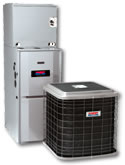|
|
||||||||

|
||||||||
| Heating | ||||||||
| For Your Home | ||||||||
|
|
||||||||
| Gas Furnace and Boiler Replacement | ||||||||
|
Efficiency Rating Although older forced-air and hot water boiler systems had efficiencies in the range of 56% to 70%, modern heating systems can achieve efficiencies as high as 97%, converting nearly all the fuel to useful heat for the home. Conservation efforts and a new high-efficiency heating system can often cut your fuel bills and your furnace's pollution output in half. Upgrading your furnace or boiler from 56% to 90% efficiency in an average cold-climate house will save 1.5 tons of carbon dioxide emissions each year if you heat with gas, or 2.5 tons if you heat with oil.
If you live in a cold climate, it usually makes sense to invest in the highest-efficiency system available. In milder climates with lower annual heating costs, the extra investment required to go from 80% to 90%-95% efficiency may be hard to justify. When shopping for high-efficiency furnaces and boilers, look for dependability, and look for the ENERGY STAR® label. Buy a system with a good warranty and a reputable company to back it up. When buying gas and oil systems, specify sealed combustion. Sealed-combustion furnaces bring outside air directly into the burner and exhaust flue gases (combustion products) directly to the outside, without the need for a draft hood or damper. They generally burn more efficiently and pose no risk of introducing dangerous combustion gases into your house. In furnaces that are not sealed-combustion units, back-drafting of combustion gases can be a big problem. Efficiency Rating An all-electric furnace or boiler has no flue loss through a chimney. The AFUE rating for an all-electric furnace or boiler is between 95% and 100%. The lower values are for units installed outdoors because they have greater jacket heat loss. The higher cost of electricity in most parts of the country makes all electric furnaces or boilers an uneconomic choice, despite their high efficiency. If you are interested in electric heating, you might consider installing a heat-pump system. The minimum allowed AFUE rating for a noncondensing fossil-fueled, warm-air furnace is 78%; the minimum rating for a fossil-fueled boiler is 80%; and the minimum rating for a gas-fueled steam boiler is 75%. A condensing furnace or boiler condenses the water vapor produced in the combustion process and uses the heat from this condensation. The AFUE rating for a condensing unit can be much higher (by more than 10 percentage points) than a noncondensing furnace. Although a condensing unit costs more than a noncondensing unit, the condensing unit can save you money in fuel costs over the 15 to 20-year life of the unit. Source: U.S. DOE, Office of Building Technology, State, and Community Programs. Photo: Heil Heating and Cooling | ||||||||
| ||||||||
|
||||||||
